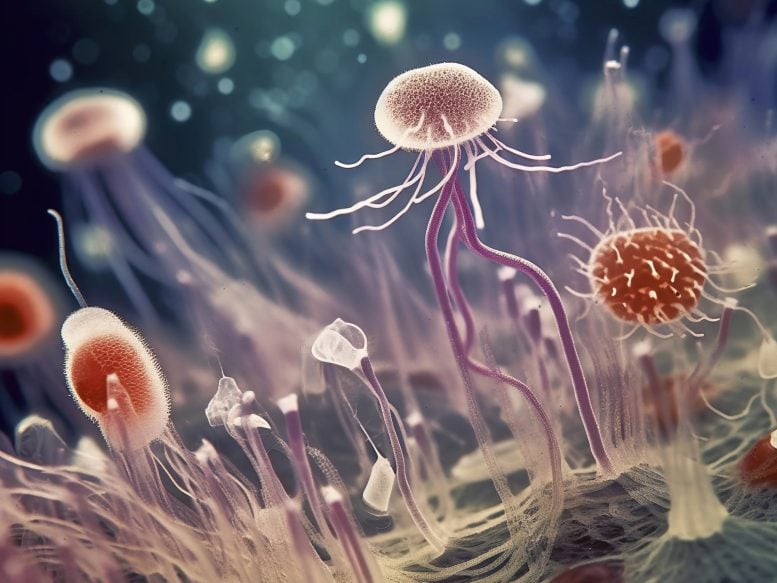
Artist’s imagination of an assemblage of primordial eukaryotic organisms of the ‘Protosterol Biota’ inhabiting a bacterial mat on the ocean floor. Based on molecular fossils, organisms of the Protosterol Biota lived in the oceans about 1.6 to 1.0 billion years ago and are our earliest known ancestors. Credit: Orchestrated in MidJourney by TA 2023
Until now, certain biomarkers, the “protosteroids,” have been overlooked as fossil witnesses to primordial life.
Newly discovered biomarker signatures point to a whole range of previously unknown organisms that dominated complex life on Earth about a billion years ago. They differed from complex eukaryotic life as we know it, such as animals, plants, and algae in their cell structure and likely metabolism, which was adapted to a world that had far less oxygen in the atmosphere than today. An international team of researchers, including GFZ geochemist Christian Hallmann, now reports on this breakthrough for the field of evolutionary geobiology in the journal Nature.
The previously unknown “protosteroids” were shown to be surprisingly abundant throughout Earth’s Middle Ages. The primordial molecules were produced at an earlier stage of eukaryotic complexity — extending the current record of fossil steroids beyond 800 and up to 1,600 million years ago. Eukaryotes is the term for a kingdom of life including all animals, plants, and algae and set apart from bacteria by having a complex cell structure that includes a nucleus, as well as a more complex molecular machinery.
“The highlight of this finding is not just the extension of the current molecular record of eukaryotes,” Hallmann says: “Given that the last common ancestor of all modern eukaryotes, including us humans, was likely capable of producing ‘regular’ modern sterols, chances are high that the eukaryotes responsible for these rare signatures belonged to the stem of the phylogenetic tree.”
Eukaryotes are one of the three recognized domains of cellular life, the other two being bacteria and archaea. The defining characteristic of eukaryotes is that they have cells with a nucleus, which houses their genetic material. The term “eukaryote” is derived from the Greek words “eu” meaning “true” and “karyon” meaning “nut” or “kernel,” referring to the nucleus.
Unprecedented glimpse of a lost world
This “stem” represents the common ancestral lineage that was a precursor to all still-living branches of eukaryotes. Its representatives are long extinct, yet details of their nature may shed more light on the conditions surrounding the evolution of complex life. Although more research is needed to evaluate what percentage of protosteroids may have had a rare bacterial source, the discovery of these new molecules not only reconciles the geological record of traditional fossils with that of fossil lipid molecules, but yields a rare and unprecedented glimpse of a lost world of ancient life. The competitive demise of stem group eukaryotes, marked by the first appearance of modern fossil steroids some 800 million years ago, may reflect one of the most incisive events in the evolution of increasingly complex life.
“Almost all eukaryotes biosynthesize steroids, such as cholesterol that is produced by humans and most other animals” adds Benjamin Nettersheim from the University of Bremen, first author of the study—“due to potentially adverse health effects of elevated cholesterol levels in humans, cholesterol doesn’t have the best reputation from a medical perspective. However, these lipid molecules are integral parts of eukaryotic cell membranes where they aid in a variety of physiological functions. By searching for fossilized steroids in ancient rocks, we can trace the evolution of increasingly complex life.”
What the Nobel laureate thought impossible…
Nobel laureate Konrad Bloch had already speculated about such a biomarker in an essay almost 30 years ago. Bloch suggested that short-lived intermediates in the modern biosynthesis of steroids may not always have been intermediates. He believed that lipid biosynthesis evolved in parallel with changing environmental conditions throughout Earth’s history. In contrast to Bloch, who did not think that these ancient intermediates could ever be found, Nettersheim started searching for protosteroids in ancient rocks that were deposited at a time when those intermediates could actually have been the final product.
But how to find such molecules in ancient rocks? “We employed a combination of techniques to first convert various modern steroids to their fossilized equivalent; otherwise we wouldn’t have even known what to look for,” says Jochen Brocks, professor at the Australian National University who shares the first authorship of the new study with Nettersheim. Scientists had overlooked these molecules for decades because they do not conform to typical molecular search images. “Once we knew our target, we discovered that dozens of other rocks, taken from billion-year-old waterways across the world, were oozing with similar fossil molecules.”
The oldest samples with the biomarker are from the Barney Creek Formation in Australia and are 1.64 billion years old. The rock record of the next 800 million years only yields fossil molecules of primordial eukaryotes before molecular signatures of modern eukaryotes first appear in the Tonian period. According to Nettersheim “the Tonian Transformation emerges as one of the most profound ecological turning points in our planet’s history.” Hallmann adds that “both primordial stem groups and modern eukaryotic representatives such as red algae may have lived side by side for many hundreds of millions of years.”
During this time, however, the Earth’s atmosphere became increasingly enriched with oxygen — a metabolic product of cyanobacteria and of the first eukaryotic algae that would have been toxic to many other organisms. Later, global “Snowball Earth” glaciations occurred and the protosterol communities largely died out. The last common ancestor of all living eukaryotes may have lived 1.2 to 1.8 billion years ago. Its descendants were likely better able to survive heat and cold as well as UV radiation and displaced their primordial relatives.
Since all stem group eukaryotes are long extinct, we will never know for certain how most of our early relatives looked like, but artistic efforts have created tentative visualizations (see pictures attached), while the primordial steroids may eventually shed more light on their biochemistry and lifestyle. “Earth was a microbial world for much of its history and left few traces.” Nettersheim concludes. Research at ANU, MARUM, and GFZ continues to pursue tracing the roots of our existence — the discovery of protosterols now brings us one step closer to understanding how our earliest ancestors lived and evolved.
For more on this research:
Reference: “Lost world of complex life and the late rise of the eukaryotic crown” by Jochen J. Brocks, Benjamin J. Nettersheim, Pierre Adam, Philippe Schaeffer, Amber J. M. Jarrett, Nur Güneli, Tharika Liyanage, Lennart M. van Maldegem, Christian Hallmann and Janet M. Hope, 7 June 2023, Nature.
DOI: 10.1038/s41586-023-06170-w

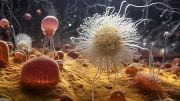

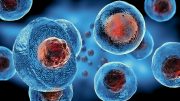
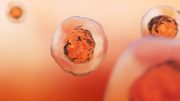

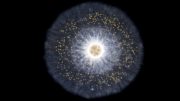
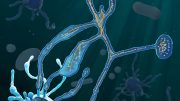
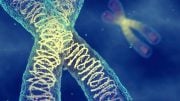
These biomarkers are not the reason for the late evolution of complex life. The evolution of the 21st and 22nd amino acids was. Without hypro and hylys, and the oxygen they require, the evolution of connective tissue collagens would not have been possible. Structural proteins were the key to complex life (the Metazoa), not those biomarkers.
let’s put aside the fact that no species became another different species ever not billions of years ago not now yet without this knowledge it is a matter of common sense when you see any animal that ever existed that no drastic changes are possible
@Ken: The article doesn’t claim that sterol evolution was a reason for evolution or delayed evolution of complex life. The discovery is used to help date the geological record versus the genomic record better as well as expand on what evolution took place.
The evolution of body plan complex animals is an open question.
Presumably you mean the hydroxylated amino acids, hydroxyproline and 5-hydroxylysine!? Many prokaryotes produce collagen-like proteins. “Understanding of sequence requirements for animal-derived collagen led to the discovery of prokaryotic collagen-like protein in the early 2000s.” [“Prokaryotic Collagen-Like Proteins as Novel Biomaterials”, 2022]
@Wtf?: You are commenting on a topic you should look into. Anyone can visit the open access NCBI site (for example) and use their genomes and softwares to observe how species evolve into other species in a few minutes. Of course, you may have to set aside 2-3 hours to learn how to do it, but these science resource sites provide the teaching material as well.
That is the observed fact, anyone can observe it instead of claiming the erroneous opposite and when doing so they have to put aside their personal opinion ‘common sense’ and use the senses evolution provided for them.
they have absolutely no clue how a finger came into being yet there certain that a bacteria just like the ones today invented all of gods creatures lol
If you believe that an ant became an elephant then you believe in evolution lol
Some moron is using Bible Studies to examine fossil evidence. Wow, get a grip pal ? There are some somewhat stable biological compounds that are left behind as evidence to use for hypothesis, now your attacking the messenger. The ultrastructure of all eukaryotic cells plant, animal, fungus, etc.. have similar components and similar molecules fact get over it…. They are all related with the same kind of DNA. DughhhH
That is of course one of the strongest and here most obvious evidences of evolution! (Which I guess another example of tripped the protection reflex of someone who doesn’t know simple biology and medicine and we try to clarify for.)
It is because we have common ancestors, and time ordered as the protosterol-to-sterol transition show, that we can sometimes use natural compounds as medicine.
The other two main evidences of evolution is genome evolution, which is also mixed into the article topic, and the biogeodiversity spread from an ancestral origin location. For humans it was Africa, say.